During the initial outbreak of COVID-19, we published a report on the underlying long-term trends supporting data infrastructure. Since then, much about the world as we knew it has changed.
During the initial outbreak of COVID-19, we published a report on the underlying long-term trends supporting data infrastructure. Since then, much about the world as we knew it has changed.
During the initial outbreak of COVID-19, we published a report on the underlying long-term trends supporting data infrastructure. Since then, much about the world as we knew it has changed. Laurence Monnier assesses how many of the trends we identified remain intact and whether the surge in demand for data services and infrastructure will translate into investment opportunities.
Lockdown measures have influenced the way we use the internet and extended it to new territories. As large swathes of the population have begun working from home a number of trends have emerged:
Unsurprisingly, data traffic has grown significantly across Europe and the rest of the world (as shown in Figure 1).
Figure 1: Change in internet traffic
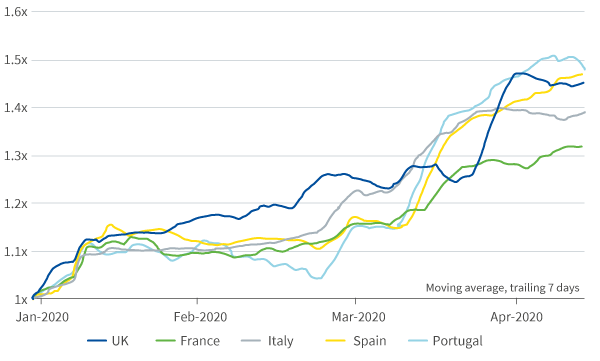
Source: Cloudflare, June 2020
In some countries, data usage increased immediately in March, while other countries (France, Italy), experienced more progressive growth. These differences may have less to do with the nature of lockdowns (which were stringent throughout Europe) than with the activities favoured by people while at home. Video streaming accounts for much of the increase in traffic: viewing hours had increased 70 per cent in Europe in the first quarter, more than in any other region globally.1
Figure 2: Increase in viewing hours Q1 2020 vs. Q1 2019
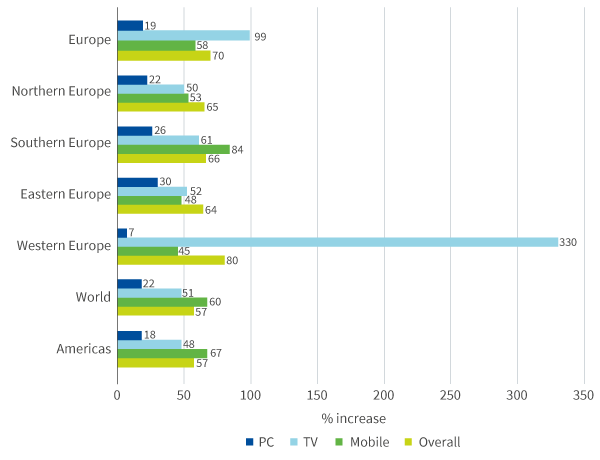
Source: Conviva, Q1 2020
Netflix reported 15.8 million new subscribers the first quarter, more than double its previous forecasts,2 while Disney’s new video streaming service added 22 million subscribers as lockdown restrictions took hold across Europe.3 The increase in on-demand streaming was so rapid that European Union commissioner Thierry Breton called on content providers to switch to standard definition feeds to prevent networks from being overloaded.
Nevertheless, social distancing has broadened our use of the internet in many other parts of our lives. Of course, this surge has accelerated some pre-existing demand. The pace of new online video and gaming subscriptions should slow as more people return to work. However, this experience has demonstrated “remote living” is possible in more areas than most people thought, creating a new and enduring demand for data.
Figure 3: Google search terms frequency (worldwide)
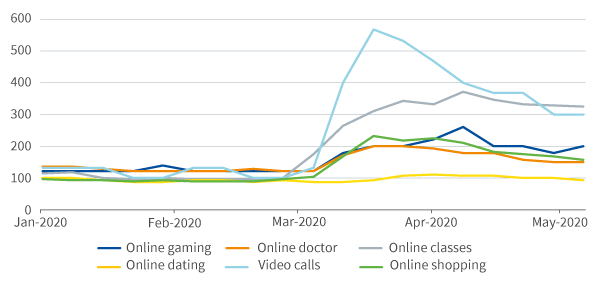
Source: Google, June 2020
Critically, many of these new applications require two-way data traffic, which will put more pressure on existing infrastructure.
By and large, European networks have reacted well to the upsurge of data. The UK’s communication regulator Ofcom reported a modest two per cent aggregate decrease in download speed in March – but this could reach six per cent at peak time for some networks. Meanwhile, Uswitch, the comparison site, said it had seen a ten per cent rise in people searching for faster broadband suppliers since coronavirus restrictions came in.4 This is not surprising as 25 per cent of UK households have internet speeds of less than 30 Mbits per second.5
Figure 4: Change in UK broadband download speed (March 2020)
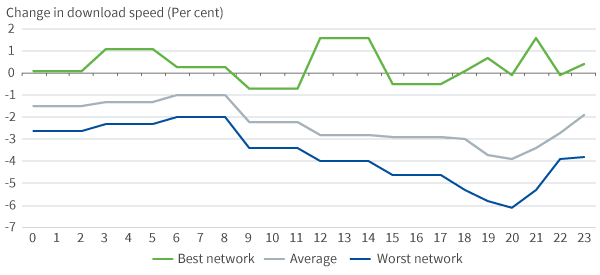
Source: Ofcom, May 2020
As working from home becomes more prevalent, families are likely to combine multiple internet uses at the same time, for example children streaming videos while parents are working. This will accelerate the need for faster internet connection. Demand for ‘fibre to the home’ or ‘fiber to the premises’ (FTTH / FTTP), which offers the fastest connection speed and high upload capacity, is likely to benefit. This is particularly true in rural areas that do not yet have access to fibre connections.
Figure 5: UK broadband network download speed compared with application data requirement (UK, 2019)
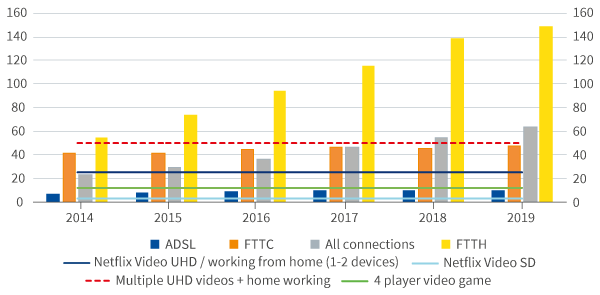
Source: Ofcom, Aviva Investors, 2020
In the near term, the rollout of new FTTH networks has been disrupted due to access limitations during lockdown, but revenues should increase once these issues are resolved.
As demand for data increases, logic suggests an increase in demand will follow for data centres where data can be stored and processed. As the workforce becomes more diffuse and less centralised, companies of all sizes may well see outsourced IT services and cloud-based systems as a more efficient way to manage their IT infrastructure. Data centres and companies offering resilient and secure services are expected to benefit. Investors have recognised this, and the share price of data centre real estate investment trusts (REITs) was quick to rebound as evidenced below.
Figure 6: US data centre REIT share prices
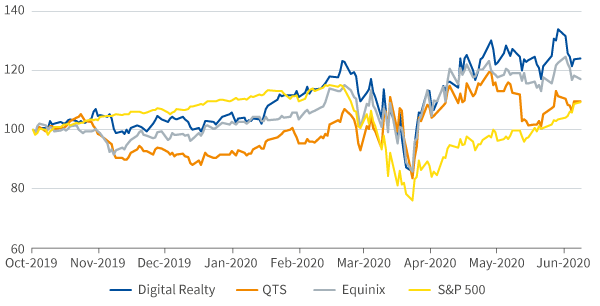
Source: Bloomberg, June 2020
The past few years have seen a steady rise of co-location data centres, where companies can rent computing space, equipment and associated services. In the near term, such facilities are exposed to an increased risk of tenant default as the economic crisis unfolds, and some tenants may seek to renegotiate terms.
Figure 7: Revenues from wholesale and retail co-location data centre
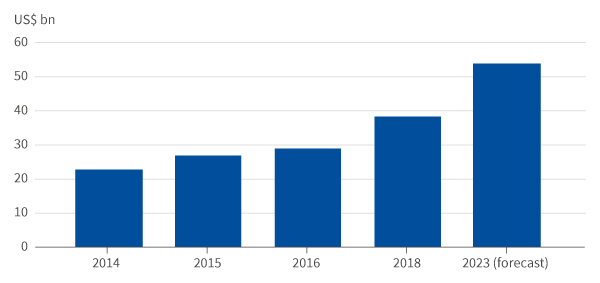
Source: 451 research, April 2019
Longer term though, we expect more companies to move their IT systems to the cloud, underpinning a strong demand for the sector. KKR’s recent announcement to invest $1bn in a data centre platform confirms investor confidence in the sector is high.
While the demand for data is clear, the revenue drivers are more nuanced. Some of the increased demand, such as on-demand video, has a revenue stream associated to it. Yet much of the new demand comes from free applications, such as Zoom calls or online news, or supports public services.
Data has become essential, yet revenues for the sector are likely to increase at a slower rate than the underlying demand. Infrastructure providers are not directly exposed to data volume. Yet, amid growing demand, investors should remain focused on the long-term business case for their investment. In the short term, where such infrastructure is rented to companies, the quality of tenant will drive asset performance. In the long term, the current crisis could well accelerate the displacement of older technologies by faster networks.
References
‘Conviva’s State of Streaming Q1 2020: Europe’, Conviva, 2020